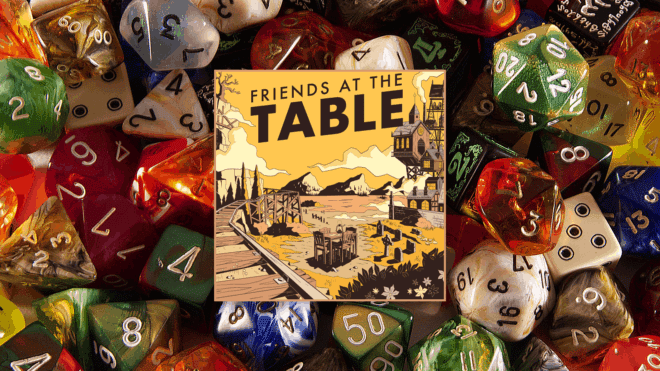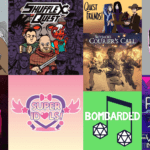How Friends At The Table Spreads Around Authorship

In the field of actual play podcasts, the DM/GM usually ends up feeling like the primary author. Typically they are the ones sculpting the larger narrative and constructing scenarios to which their players respond. Even with GMs who are open to player ideas and willing to tweak their own material in response to their players’ impulses, there still persists an aura of authorship.
Friends At The Table has a distinctly different approach. For one, the show has a uniquely large pool of players, with 8 cast members: Austin Walker, Sylvia Clare, Jack De Quidt, Alicia Acampora, Keith Carberry, Janine Hawkins, Art Martinez-Tebbel, and Andrew Lee Swann. This large core cast regularly swaps in and out for sessions. Seasons are often split among multiple parties, with players occasionally switching groups when the story requires, or gives them the opportunity. Among all of these distinct dramatic voices, Austin Walker is the host and de facto GM, but that doesn’t mean the other seven players are actors awaiting their lines. Rather, the atmosphere cultivated by Walker is one of constant collaboration, and the authorial power each player wields means that the stories of Friends At The Table feel more important to each player because each of them has a unique position of ownership toward the worlds they create.

Apple Podcasts | Pocket Casts | Website | RSS
Friends at the Table is currently in its seventh season, a dark fantasy/horror/western story called Sangfielle. Previous seasons have alternated between a fantasy setting (Season 1, 3, and 5) and hard sci-fi regarding giant mechs (seasons 2, 4, and 6). Across these seasons, while much of the episodes are the usual actual play format of players maneuvering their respective characters through the situation Walker sets up, there are also frequent stretches of episodes using other game systems, specifically GMless games that let the fate of the story fall to the group as a whole.
Read more: The 69 Nicest Actual Play Podcast Highlights of 2020
Seasons also often begin with world-building games, such as Microscope or The Quiet Year, through which the entire table can share the creative power (and the responsibility / effort) of establishing their new starting status quo. While each season beginning with a world-building game isn’t unique in and of itself, what is special to Friends at the Table is how, even in play, the performers always have a unique control over their narrative. This communal effort of expanding and deepening the lay of the land means that every player has distinct fingerprints on the world at large.
The players fill in the world, but they should always leave room for themselves or others to build forward, expanding on their own and each other’s ideas.
The use of collaborative story games isn’t just how games begin — they’re also often how they end. The three fantasy seasons, collectively called Seasons of Hieron, tells a single story with the same cast of characters, and it ends in a collaborative game, The Quiet Year by Avery Alder. After three years of investing in these characters and this world, the final fate of those within it isn’t left up to just the GM’s ideas for an epilogue. After so many hours of playing together, it stands to reason that everyone who’s had a hand in the story for so long should have a hand in writing the ending.
In the first episode of the series, Austin Walker mentions a guiding principle he wants to keep in mind as they go forward: “Draw maps but leave blanks.” This is both a practical statement, suggesting that the players shouldn’t over-plan and potentially write themselves into a corner, and a broader philosophy on the nature of Actual Play storytelling: the players fill in the world, but they should always leave room for themselves or others to build forward, expanding on their own and each other’s ideas. So much of the narrative thrill of Friends At The Table comes from moments where previously blank parts of the map get suddenly filled in, either by a player decision or a narrative reveal. No matter where these revelations come from, they always rooted in the original layout of the world as dictated by the group.
Structurally, Friends At The Table uses games to optimize GM-less, evenly-distributed authorship. But beyond the games they play, the company of players speak openly and frankly about how they want to story to work. In these moments, Friends At The Table plays as a writer’s room podcast as much as it is an actual play one. The first episode actually doesn’t feature a world-building game, but instead a shared discussion of what kind of fantasy setting they want for the story. People talk about their history with Tolkien and Tolkien-adjacent fantasy, discuss their expectations and what kind of stories, cultures, and events they’d be interested in exploring. Not a single dice is rolled in this episode. There’s no reason one should be, really, as the entire discussion is framed as just that: a discussion.
Many modern TTRPGs have rules that encourage players to view playing as a conversation, a give-and-take between parties to uncover the most interesting way for events to transpire. Friends At The Table excels at this conversational style of play, and goes further, with play often just completely morphing into a conversation between the two players instead of any characters. This is the writers room atmosphere appearing again — multiple times in the show’s history, a character’s ultimate fate, whether they live or die in a present moment, is hashed out on air, with Walker and the player considering what the narrative fallout of any choice might be.
The strings are supposed to show — indeed, showing how they hang the strings is perhaps the whole point
Players also still have an enormous amount of narrative sway within the seasons, outside of major GMless games. For the show’s first sci-fi season, called COUNTER/Weight, half the players controlled specific characters in weekly missions, while the other half controlled larger factions entirely — a consistent example of players influencing the larger story beats of the entire game. In their most recent sci-fi season, called PARTIZAN, one player controls a character that is the first on-screen representation of an often-mentioned alien species, which was a major step forward for that universe’s worldbuilding. The team’s willingness to take these major swings, and Walker’s ability to roll with their choices and incorporate them into the larger overall narrative without it ever feeling out of place, are key examples of Friends At The Table’s narrative prowess.
At the beginning of each episode, Walker says that Friends at The Table is “an actual play podcast focused on critical world-building, smart characterization, and fun interactions between good friends.” These spoken priorities are easy to see borne out by the flow of any episode. In the moment-to-moment play of Friends At the Table, players rarely go for immersion or try to use distinct “character voices” to disappear into a role or hide the metaphorical strings of the project. Again, their priority is more focused on the ways they tell the story and how they use the mechanisms of their respective games to do so. The strings are supposed to show — indeed, showing how they hang the strings is perhaps the whole point.
Read more: Playing With Strangers: Dissecting Dark Dice
The podcast has a distinctly Brechtian flavor to it at times, where the last thing on anyone’s minds, outside of Walker’s scripted intros, is immersion. The priority of “critical world-building” is key here: the players are trying to be critical and conscious of every story they tell. The Hieron seasons are deeply critical of Tolkien-esque fantasy’s blindspots, as the seasons about giant mechs in space are critical of imperialist war machines and the glorification of combat. Therefore, players need to keep one foot in reality as they devise each new move and consider what, for example, moments of sudden violence might mean in the larger story’s context. The result is a story that is still entertaining and deeply hilarious (“fun interactions between good friends” is a key belief too, after all) as well as pulse-poundingly exciting or scary. The emotional depth doesn’t come from the fictional characters, but the real-world investment the players have in said characters.
Friends At the Table tells effective stories because everyone involved is both a tremendously talented storyteller and, perhaps more importantly, a tremendously talented collaborator. Episodes can deliver thrilling action sequences, gut-twisting emotions, and mind-expanding philosophical concepts, all with charm and warmth. The games they play are useful catalysts for these stories, but these episodes’ staying power comes from the entire team’s dedication to making the best story possible, and finding the best way to make their choices feel at once part of a grander narrative and indicative of their own narrative power. In doing so, the cast of Friends at The Table put forward a convincing argument that the best mode of storytelling is evenly-distributed, or at least open to collaboration.













1 comment
Pingback Podcast Spotlight: The Lavender Tavern | Discover the Best Podcasts | Discover Pods
Comments are closed.